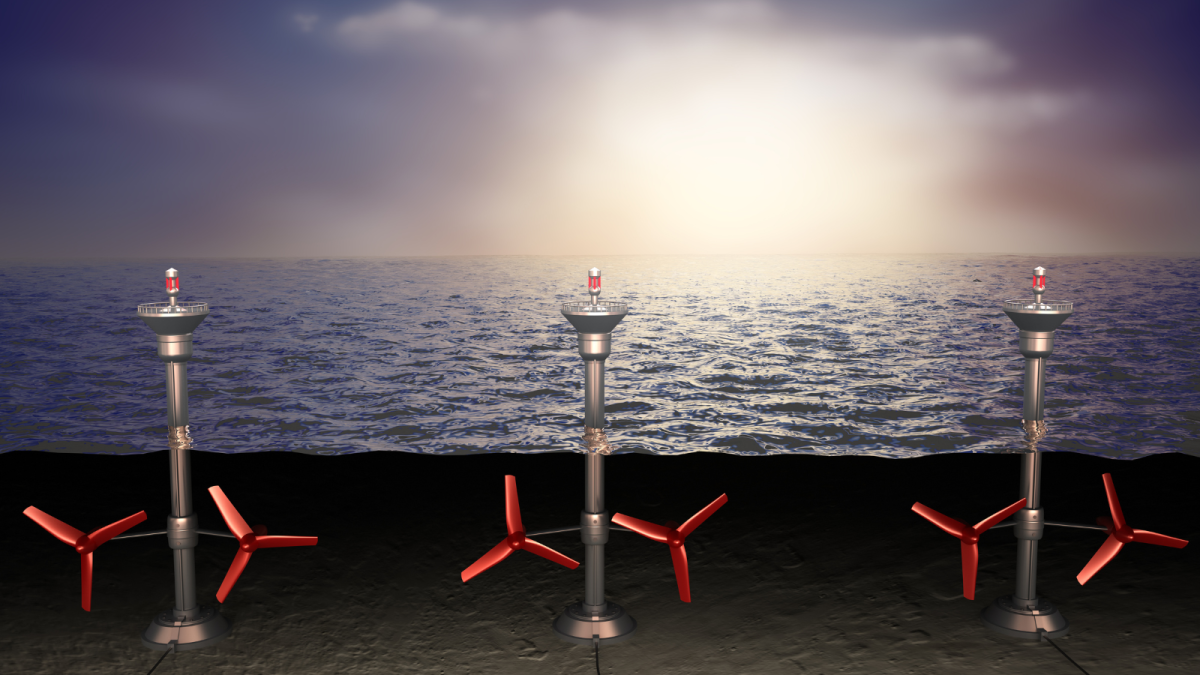By alex-mit from Getty Images Tidal energy is becoming an increasingly popular choice for those who are looking for a sustainable and renewable form of energy. Through the use of tidal energy, energy can be generated with no adverse environmental impacts, and is a viable option for those looking to reduce their carbon footprint. This post will explore what tidal energy is, how it works, and its advantages over other forms of renewable energy.
Definition of Tidal Energy
Tidal energy, also known as tidal power, is a type of renewable energy that converts the energy of ocean tides into electricity. It is a form of hydropower that harnesses the natural rise and fall of ocean waters caused by the gravitational pull of the moon and the sun. This power is generated through the use of specially-designed turbines and other specialized equipment that can be placed in coastal waters. Tidal energy is a clean, renewable energy source with little to no environmental impact, making it an attractive alternative to more traditional energy sources.
Advantages of Tidal Energy
The advantages of tidal energy are vast and far-reaching. It is a clean, renewable source of energy that does not produce any pollutants. This makes it a much more environmentally friendly source of energy than fossil fuels. Here are some benefits of tidal energy:
1. Renewable Source of Energy
Tidal energy is a form of renewable energy that harnesses the power of the ocean tides. It can be used to generate electricity and to provide other forms of energy. Tidal energy is a clean, renewable source of energy that has the potential to provide a steady and reliable source of energy for many countries. Tidal energy is also more efficient than other forms of renewable energy, as it uses the natural movement of the ocean tides to generate energy. Tidal energy is also more predictable than other forms of renewable energy and can provide a steady and reliable source of energy.
2. No Greenhouse Gas Emissions
One of the most important advantages of tidal energy is that the renewable energy source has zero greenhouse gas emissions. Unlike other sources of energy, tidal power does not produce any emissions that can contribute to climate change. This makes tidal energy a much more eco-friendly option than other sources of energy. Additionally, tidal energy is highly efficient and can generate large amounts of power with relatively small amounts of energy input. This makes it an ideal source of renewable energy for meeting the increasing demand for electricity.
3. Low Maintenance Costs
One of the most attractive advantages of tidal energy is its low maintenance costs. Unlike other forms of renewable energy, such as wind and solar, there is no need for regular maintenance of the equipment used to capture tidal energy. This is because tidal energy is produced by the rise and fall of ocean tides, which are a natural, predictable phenomenon. As a result, any investment in tidal energy will pay off in the long term with minimal upkeep costs. By Benita5 from Pixabay
4. Consistent and Predictable Source of Energy
Tidal energy is a reliable and predictable source of energy, as tidal currents are predictable and occur in a regular cycle. This makes it an ideal choice for electricity production, as it can be relied on to produce consistent amounts of energy at any given time. Unlike other forms of renewable energy, such as solar and wind, which are dependent on the weather and can be unreliable, tidal energy production is more predictable, as it is based on the tide which can be predicted months in advance. This allows for accurate planning of energy production and helps to ensure a steady supply of energy.
5. High Efficiency
One of the biggest advantages of tidal energy is its high efficiency. Tidal energy harnesses the natural energy of ocean tides and currents to generate power in a clean, renewable way. This energy is extremely efficient, as tides and currents are consistent and predictable, meaning that it is easier to forecast how much energy can be generated at a given time. Additionally, because of its predictability and consistency, tidal energy can be stored and used as needed, making it a more reliable energy source than other renewable sources.
6. Can Be Used in Shallow and Deep Water
One of the major advantages of tidal energy is its versatility. Tidal energy can be used in both shallow and deep water, allowing for a wider range of potential locations. In shallow water, turbines can be suspended from the sea surface, while in deep water, they can be placed on the seabed. This makes tidal energy an attractive choice for coastal areas, as well as estuaries, rivers, and harbors. Additionally, this versatility means that tidal energy can be used in locations with varying tidal ranges and depths, which makes it more accessible than some other forms of renewable energy.
7. Easily Integrated With Other Renewable Sources
One of the major advantages of tidal energy is that it can be easily integrated with other renewable energy sources. This makes it ideal for powering densely populated coastal regions that also rely on solar, wind, and other renewable energy sources. Tidal energy can also be used to supplement these other sources when they are unable to meet the demand for energy. With the right turbines and systems in place, the energy produced by tides can easily be integrated with other renewable sources, allowing for a more reliable, continuous supply of energy.
8. Low Risk of Mechanical Failure
Tidal energy has a much lower risk of mechanical failure than other forms of renewable energy. This is due to the fact that the energy is derived from a natural, predictable force, and the technology is relatively simple. As a result, the costs associated with maintaining a tidal energy system are much lower than those associated with a solar or wind system. This makes it a particularly attractive option for communities looking to reduce their reliance on non-renewable sources of energy.
Disadvantages of Tidal Energy
Despite the many advantages of tidal energy, it is important to consider a few potential drawbacks before investing in this technology.
1. High Initial Investment Costs
A major disadvantage of tidal energy is its high initial investment costs. These costs include the cost of building the tidal dams, turbines, and other infrastructure necessary to generate the energy. In addition, the cost of installing and maintaining these components is also quite high. This makes tidal energy cost-prohibitive for many small-scale or developing countries. This high cost can also discourage private investors from investing in the development of tidal energy projects.
2. Weather Dependent
One of the disadvantages of tidal energy is its weather dependence. Since tides are produced by the gravitational pulls of the sun and moon, they are affected by weather patterns. Stormy weather conditions can cause the tides to be more intense while calmer weather can result in weaker tides. By Cacaroot from Getty Images This means that tidal power plants will have much less energy available when the weather is not ideal. This can cause significant disruptions in the energy supply and make it difficult for the power plant to supply enough energy on a regular basis.
3. Impact on Marine Life
One of the biggest drawbacks of tidal energy is its potential environmental impact on marine life. As the turbines generate electricity, they can disrupt the natural flow of the tides, which can affect the migration patterns of fish and other marine animals. Additionally, the turbines can be a hazard for marine animals, as they can get caught in the spinning blades and suffer serious injury or death. The noise generated by the tidal power plant may also disturb the habits of marine animals. Finally, the installation of the turbines can also disrupt the seabed and affect the local marine ecosystem.
4. Limited Locations
Another disadvantage of tidal energy is its limited availability. Tidal energy can only be utilized in coastal areas, where there is a significant difference in the tide level at high and low tide. In addition, tidal power plants must be built in areas where the current is strong, and the tidal range is greater than four meters. By Yacald from Getty Images This limits the number of possible locations for tidal energy plants, which can make it difficult to find suitable sites. Another limiting factor is the environmental impact of building tidal power plants in certain areas, which means that only certain locations are viable for tidal energy production.
5. Unpredictable Outputs
One of the key disadvantages of tidal energy is its unpredictable outputs. Tidal energy is dependent on the lunar and solar cycles, which can make it hard to plan for future energy needs. As the tides vary from day to day, it can be difficult to predict the precise amount of energy that will be produced in any given day. This means that energy companies are forced to rely on other sources to meet their energy needs, which can be both costly and inefficient.
How Does Tidal Energy Work
Tidal energy works by harnessing the power of the ocean’s tides. It is a renewable energy source that harnesses the energy of the rising and falling tides. The most common type of tidal energy technology is called tidal barrages. These consist of large walls or dams that span across river estuaries or bays. As the tide rises, the water is held back by the barrage, and as the tide ebbs, the water is released through turbines that generate electricity. The turbines rotate as the water passes through them, creating a current that generates electricity. This electricity is then transferred to the power grid, where it can be used to power homes and businesses.
Types of Tidal Power Plants
Tidal power plants are a type of renewable energy that harnesses the energy of the tides to generate electricity. The following paragraphs provide an overview of the different types of tidal power plants, their advantages and disadvantages, and the challenges associated with their development. Learn more about these innovative energy sources and their potential for the future.
1. Tidal Barrage
A tidal barrage is a type of hydropower system that uses the power of the ocean tides to generate electricity. It is essentially a dam that is built across an estuary or bay, and as the tides rise and fall, the water is allowed to pass through the barrage, creating a force that is used to turn turbines. The turbines then generate electricity, which is then sent to the power grid. Tidal barrages are attractive as a source of renewable energy because they are not affected by the weather or climate, they can be built in coastal areas with large tidal ranges, and they have the potential to produce large amounts of energy. In addition, they can be designed to help control flooding and to protect coastal areas from erosion.
2. Tidal Fence
A tidal fence is a structure that is used to capture and harness energy from the movement of tidal waters. This energy is then used to generate clean and renewable electricity. A tidal fence consists of a series of turbines that are connected together in a long line. By Gwenvidig from Getty Images The turbines are connected to a generator, which produces electricity when the turbines rotate due to the movement of the tidal waters. The system is designed to generate as much power as possible from the tides, and can be used to power homes and businesses. Tidal fences are becoming increasingly popular as a renewable energy source, as they are extremely cost effective and can produce large amounts of electricity with minimal environmental impact.
3. Tidal Stream Turbines
Tidal stream turbines are an emerging renewable energy source that has the potential to revolutionize the way we generate electricity. These turbines are designed to extract energy from the movement of ocean tides, and convert it into electricity. The energy created is clean, renewable, and abundant. Tidal stream turbines are mounted on the seabed, and operate by the movement of the tides. The blades of the turbines spin and cause the generator to produce electricity.
4. Tidal Lagoon
A tidal lagoon is an artificial, man-made structure or basin that is built along a coastline. It collects the energy from the tides, which is then used to generate electricity. It is an attractive option for renewable energy because of its predictability and reliability. The energy generated from tidal lagoons is capable of powering hundreds of thousands of homes. Tidal lagoons also provide many environmental benefits, such as reducing the amount of carbon dioxide being released into the atmosphere and providing habitats for marine life. Furthermore, they can also help prevent coastal flooding by allowing the ocean to collect and store excess water.
5. Tidal Impoundment
Tidal Impoundment is a method of harnessing the energy of the tides to generate electricity. This type of renewable energy technology utilizes the tidal range, which is the difference in height between high and low tides, to capture and store water in a reservoir. As the tide rises and falls, the water is released from the reservoir to turn turbines and generate electricity. By Annette Marie from Annette Marie’s Images The potential of tidal power is significant, as the tides are reliable and predictable sources of energy. They can provide a steady and consistent source of electricity, which can help reduce emissions from traditional sources of energy.
Applications of Tidal Energy
Tidal energy can be used to generate electricity, but there are other applications as well. One of the more interesting applications is the production of desalinated water. Tidal energy can be used to power pumps that move salt water through a reverse osmosis membrane. This process removes the salt and other minerals, producing clean, drinkable water. This is an invaluable application, especially for coastal communities that lack access to fresh water. Additionally, tidal energy can be used to power navigational buoys, lights, and other marine infrastructure.
Cost of Tidal Energy
The cost of tidal energy can vary widely depending on the scale of the project and the technology used. Generally, the cost of tidal energy is significant but still less than other sources of renewable energy, such as solar or wind. The upfront cost of a tidal energy project is usually around $130-280 megawatt-hour (MWh) of capacity. However, over its lifetime, the cost of tidal energy may be less than other forms of renewable energy due to its predictable and consistent energy production. Additionally, the cost of tidal energy is decreasing due to the development of more efficient technology.
Future of Tidal Energy
Tidal energy is a renewable form of energy that is generated from ocean tides. Tidal energy has been around for centuries, but with the development of new technology, it is becoming increasingly more viable for use as a renewable energy source. The future of tidal energy is very promising, with potential for use in both large-scale electricity generation and smaller-scale applications such as desalination and water pumps. Currently, there are several tidal energy projects being developed around the world, with the potential for more to come. This form of energy is expected to become more widespread in the coming years, as it provides a reliable and cost-effective energy source.
The Bottom Line
In conclusion, tidal energy is an efficient and renewable source of electricity. It is a reliable source of energy with predictable generating capabilities. The potential of tidal energy far exceeds the current technology being used to harness it, and many countries around the world are investing heavily in research and development to improve tidal energy capture. With more efficient technology, tidal energy could become an integral part of the global renewable energy mix in the future.
Additional Sources
This content is accurate and true to the best of the author’s knowledge and is not meant to substitute for formal and individualized advice from a qualified professional. © 2022 Muhammad Rafiq





